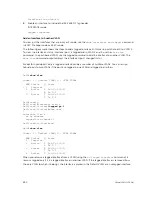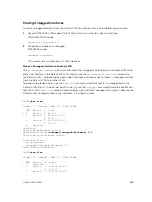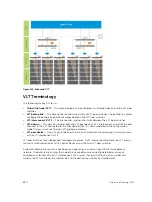
NOTE: In a VLAN, the
shutdown
command stops Layer 3 (routed) traffic only. Layer 2 traffic
continues to pass through the VLAN. If the VLAN is not a routed VLAN (that is, configured with an IP
address), the
shutdown
command has no affect on VLAN traffic.
When you delete a VLAN (using the
no interface vlan
vlan-id
command), any interfaces assigned
to that VLAN are assigned to the Default VLAN as untagged interfaces.
To create a port-based VLAN, use the following command.
• Configure a port-based VLAN (if the VLAN-ID is different from the Default VLAN ID) and enter
INTERFACE VLAN mode.
CONFIGURATION mode
interface vlan
vlan-id
To activate the VLAN, after you create a VLAN, assign interfaces in Layer 2 mode to the VLAN.
Example of Verifying a Port-Based VLAN
To view the configured VLANs, use the
show vlan
command in EXEC Privilege mode.
Dell#show vlan
Codes: * - Default VLAN, G - GVRP VLANs
NUM Status Q Ports
* 1 Inactive U So 9/4-11
2 Active U Te 1/1,18
3 Active U Te 1/2,19
4 Active T Te 1/3,20
5 Active U Po 1
6 Active U Te 1/12
U So 9/0
Assigning Interfaces to a VLAN
You can only assign interfaces in Layer 2 mode to a VLAN using the tagged and untagged commands. To
place an interface in Layer 2 mode, use the
switchport
command.
You can further designate these Layer 2 interfaces as tagged or untagged. For more information, refer to
the
Configuring Layer 2 (Data Link) Mode
. When you place an interface in Layer 2
mode by the
switchport
command, the interface is automatically designated untagged and placed in
the Default VLAN.
To view which interfaces are tagged or untagged and to which VLAN they belong, use the
show vlan
command. The following example shows that six VLANs are configured, and two interfaces are assigned
to VLAN 2. The Q column in the
show vlan
command example notes whether the interface is tagged (T)
or untagged (U). For more information about this command, refer to the Layer 2 chapter of the
Dell
Networking OS Command Reference Guide
.
To tag frames leaving an interface in Layer 2 mode, assign that interface to a port-based VLAN to tag it
with that VLAN ID. To tag interfaces, use the following commands.
1.
Access INTERFACE VLAN mode of the VLAN to which you want to assign the interface.
CONFIGURATION mode
Virtual LANs (VLANs)
843
Summary of Contents for Z9000
Page 1: ...Dell Configuration Guide for the Z9000 System 9 7 0 0 ...
Page 80: ...grub reboot 80 Management ...
Page 128: ... 0 Te 1 1 Te 1 2 rx Flow N A N A 128 Access Control Lists ACLs ...
Page 491: ...Figure 70 Configuring OSPF and BGP for MSDP Multicast Source Discovery Protocol MSDP 491 ...
Page 496: ...Figure 73 MSDP Default Peer Scenario 1 496 Multicast Source Discovery Protocol MSDP ...
Page 497: ...Figure 74 MSDP Default Peer Scenario 2 Multicast Source Discovery Protocol MSDP 497 ...
Page 498: ...Figure 75 MSDP Default Peer Scenario 3 498 Multicast Source Discovery Protocol MSDP ...
Page 760: ...Figure 100 Single and Double Tag TPID Match 760 Service Provider Bridging ...
Page 761: ...Figure 101 Single and Double Tag First byte TPID Match Service Provider Bridging 761 ...
















































